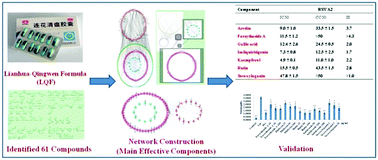A network analysis of the Chinese medicine Lianhua-Qingwen formula to identify its main effective components†
Abstract
Chinese medicine is known to treat complex diseases with multiple components and multiple targets. However, the main effective components and their related key targets and functions remain to be identified. Herein, a network analysis method was developed to identify the main effective components and key targets of a Chinese medicine, Lianhua-Qingwen Formula (LQF). The LQF is commonly used for the prevention and treatment of viral influenza in China. It is composed of 11 herbs, gypsum and menthol with 61 compounds being identified in our previous work. In this paper, these 61 candidate compounds were used to find their related targets and construct the predicted-target (PT) network. An influenza-related protein–protein interaction (PPI) network was constructed and integrated with the PT network. Then the compound-effective target (CET) network and compound-ineffective target network (CIT) were extracted, respectively. A novel approach was developed to identify effective components by comparing CET and CIT networks. As a result, 15 main effective components were identified along with 61 corresponding targets. 7 of these main effective components were further experimentally validated to have antivirus efficacy in vitro. The main effective component-target (MECT) network was further constructed with main effective components and their key targets. Gene Ontology (GO) analysis of the MECT network predicted key functions such as NO production being modulated by the LQF. Interestingly, five effective components were experimentally tested and exhibited inhibitory effects on NO production in the LPS induced RAW 264.7 cell. In summary, we have developed a novel approach to identify the main effective components in a Chinese medicine LQF and experimentally validated some of the predictions.


 Please wait while we load your content...
Please wait while we load your content...